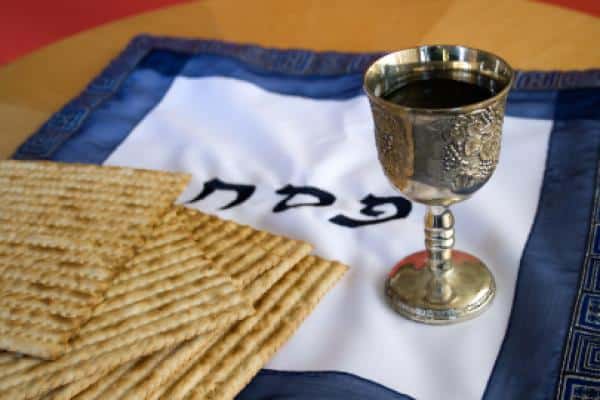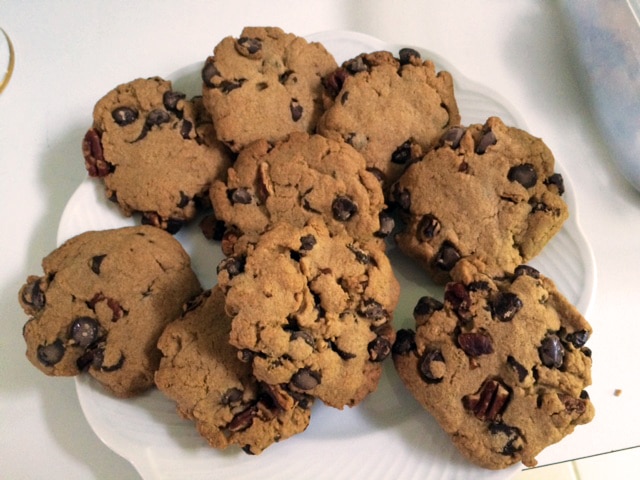Grandma Teddy’s Passover Chocolate Chip Cookie Recipe + A Little History

(Published Apr 1, 2015)
This recipe came straight from my grandmother’s kitchen. They’ve been a staple at my family Passover for as long as I can remember. I hope you enjoy them as much as I do!
Passover Chocolate Chip Cookies
You’ll need:
1 c. brown sugar
1/2 lb. butter
1/2 c. sugar
1 tsp vanilla
2 eggs
2 c. + 4 Tbs cake meal
1 c. chopped nuts
12 oz chocolate chips
Next:
Cream the sugars and butter together. Add vanilla and eggs and mix until well combined. Add Cake Meal and continue mixing. Fold in nuts and chocolate chips last. Shape and bake at 350º for 15 minutes.
A Beginners Guide to Passover
This Friday evening, the holiday of Pesach begins. For many American Jews, this is one of the most widely celebrated holidays.
Pesach, known as Passover in English, is a major Jewish spring festival, commemorating the Exodus from Egypt over 3,000 years ago. The ritual observance of this holiday centers around a special home service called the seder (meaning “order”) and a festive meal; the prohibition of chametz (leaven); and the eating of matzah (an unleavened bread). On the fifteenth day of Nisan in the Hebrew calendar, Jews gather with family and friends in the evening to read from a book called the haggadah, meaning “telling,” which contains the order of prayers, rituals, readings and songs for the Passover seder. Today, the holiday is a celebration of freedom and family.
The name Pesach is derived from the Hebrew word pasach, which means “passed over,” which is also the source of the common English name for the holiday. It recalls the miraculous tenth plague when all the Egyptian firstborn were killed, but the Israelites were spared. The story of Passover originates in the Bible as the telling of the Exodus from Egypt. The Torah recounts how the Children of Israel were enslaved in Egypt by a Pharoah who feared them. After many generations of oppression, God speaks to an Israelite man named Moses and instructs him to go to Pharoah and let God’s people go free. Pharoah refuses, and Moses, acting as God’s messenger brings down a series of 10 plagues on Egypt.
Along with Sukkot and Shavuot, Passover is one of the Shalosh Regalim, or Three Pilgrimage Festivals, during which people gathered in Jerusalem with their agricultural offerings in ancient times. There are several mitzvot (commandments) unique to Passover, which are evident in the customs and rituals of the holiday to this day: matzah (the eating of unleavened bread); maror (the eating of bitter herbs); chametz (abstention from eating leaven); b’iur chametz (removal of leaven from the home); and haggadah (participation in the seder meal and telling the story).
The seder is the centerpiece of any Passover experience. A seder is an elaborate festive meal that takes place on the first night(s) of the holiday of Passover. Family and friends join together to celebrate. The word seder literally means “order,” and the Passover seder has 15 separate steps in its traditional order. These steps are laid out in the Haggaddah, the book used during the seder. Many congregations hold a community seder during at least one night of Passover. There are also synagogue services held during the first day(s) of the holiday.
The seder plate contains various symbolic foods referred to in the seder itself. The contents of a seder plate vary by tradition, but most of them contain a shank bone, lettuce, an egg, greens, a bitter herb, and a mixture of apples, nuts and spices.
The following symbolic foods should be placed near the leader of the Seder. During the course of the Seder, they are pointed out, lifted up and displayed, and explained.
On the Seder plate (use either a special one for this purpose or a regular dinner plate), include:
- Shank bone, zaro’ah, symbolizes the lamb that was sacrificed in ancient days
- Roasted Egg, beitzah, represents the Passover offering of ancient days as well as the wholeness and continuing cycle of life
- Bitter herbs, maror (horseradish or romaine lettuce), a reminder of the bitter lives of the Hebrew slaves
- Charose, the mixture of apples, nuts, sweet wine, cinnamon and sugar in the Ashkenazic fashion or dates, nuts and sweet wine in the Sephardic tradition, reminds us of the bricks and mortar made by the Hebrew slaves
- Greens, karpas, symbolizes the springtime of the year when Passover takes place
Also place on the table:
- Three matzot (pl. of matzah), on a plate with a cloth or napkin cover
- Salt water, a reminder of the tears shed by the Hebrew slaves
- Cup of Elijah, Kos Eliyahu
Enjoy for all who celebrate!
Jon

